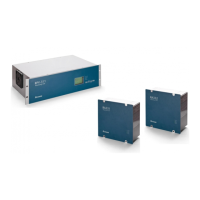Chapter 2 – Safety Information
Testing may leave capacitors charged to dangerous voltage levels. Discharge capacitors by
reducing test voltages to zero before disconnecting test leads.
If the equipment is used in a manner not specified by the manufacturer, the protection
provided by the equipment may be impaired.
Operate the equipment within the specified electrical and environmental limits.
Before cleaning the equipment, ensure that no connections are energised. Use a lint free cloth
dampened with clean water.
Integration of the equipment into systems shall not interfere with its normal functioning.
The functioning of the device has been certified under the circumstances described by the
standards mentioned in Chapter 17 (item Type Tests). Usage of the equipment in different
conditions from the specified in this manual might affect negatively its normal integrity.
The equipment shall have all their rear connectors attached even if they are not being used, in
order to keep their levels of ingress protection as high as possible
Never manipulate liquid containers near the equipment even when it is powered off.
Avoid modification to the wiring of panel when the system is running.
VT circuits must never be left short circuited.
4.3 FUSING REQUIREMENTS
A high rupture capacity (HRC) fuse type with a maximum current rating of 10 Amps and a
minimum dc rating of 250 V dc may be used for the auxiliary supply (for example Red Spot
type NIT or TIA). Alternatively a miniature circuit breaker (MCB) of type C, 10A rating,
compliant with IEC 60947-2 may be used.
Digital input circuits should be protected by a high rupture capacity NIT or TIA fuse with
maximum rating of 10 A, or equivalent MCB as above. For safety reasons, current transformer
circuits must never be fused. Other circuits should be appropriately fused to protect the wire
used.

